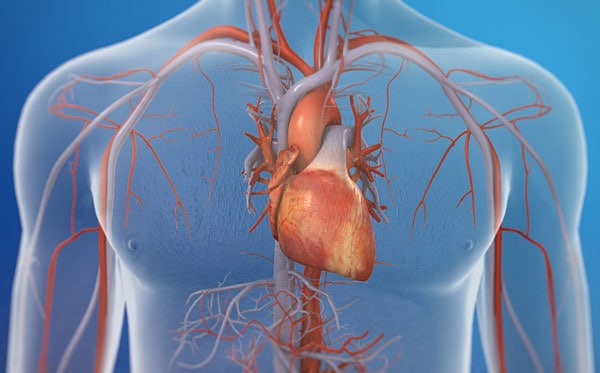My name is Sandy Foukarakis and I’m a Physician Assistant (PA) with Northeast Spine and Sports Medicine and an adjunct Professor of Anatomy & Physiology at Georgian Court University. Prior to becoming a PA, I studied exercise physiology and worked as a personal trainer and group exercise instructor. Aside from my career in medicine, I enjoy helping people learn how to exercise correctly and efficiently to target their goals. Over a few articles, I will be sharing some tips to help introduce you to effective strategies for starting an exercise regimen.
The cardiovascular system is composed of your heart, arteries and veins. Its job is to deliver oxygen and nutrients to the entire body, while also removing waste products, via the blood. If your arteries are compromised, they are not able to function efficiently or effectively and this leads to heart disease.
Heart disease is the number one cause of death in the United States and it is estimated that it’s accountable for more than 33% of US deaths annually.There are several forms of heart disease, but the most common in our country is coronary artery disease, known as CAD. CAD is caused by plaque accumulation (fat & cholesterol) in the arteries that supply the heart. CAD is a leading risk factor for heart attack and stroke, and can also cause damage to the eyes and kidneys. If this is a health condition that you or someone you know is currently dealing with, then perhaps this coronary artery disease treatment can help you. There are both modifiable and non-modifiable risk factors for heart disease. While there is not much one can do to change non-modifiable risk factors such as aging, race, gender or genetic disposition, there is plenty we can do to lower our modifiable risk.
1. Heart Healthy Diets
Diets that are low in sodium and cholesterol can help lower blood pressure and cholesterol levels, which can improve heart health (you can know more by Going Here). Cutting back on fried foods and foods that are rich in saturated fats can lead to weight loss and better cholesterol profiles. Also, adding foods that are rich in monounsaturated fatty acids, such as olive oil, nuts, avocados, can reduce LDL (a bad cholesterol) while increasing HDL (the good cholesterol). Other cardioprotective foods are those that are rich in Omega-3’s, such as fatty fish like tuna and salmon. Additionally, you can also look at this site to know more tips.2. Control Blood Pressure
High blood pressure is known as the silent killer because many times this disease has no symptoms but can cause irreversible damage to the heart, brain, kidneys and eyes. As blood pressure increases, the heart has to work harder and harder to pump against resistance and this can lead to an enlarged heart. As the heart enlarges, it looses efficacy and then has to work even harder to keep up with the oxygen and nutrient demand of the body.Goal blood pressure should be LESS THAN 120/80.Since blood pressure varies from minute to minute due to challenges our bodies face throughout the day, record blood pressures daily for 1 week, using the same arm. Consistent numbers at or above 130/90 warrant a trip to your health care provider to discuss treatment options or lifestyle modifications to lower blood pressure. If you have been diagnosed with hypertension (high blood pressure) remember to take your medications as described and tell your doctor about any side effects that may occur; instead of stopping the medication because you have a side effect, you provider can change the medication to one that has fewer side effects for you.
3. Don’t Smoke
Smoking damages the lining of blood vessels and heart, which in turn, accelerates hardening and narrowing of the arteries leading to any increase in blood pressure. Smoking can also increase the likelihood of blood clots since it can cause platelets to aggregate (clump). The combination of these two harmful side effects of smoking greatly increases a person’s risk for heart disease, and subsequently, heart attack and stroke. Low-tar or light cigarettes do not reduce the risk; the only way to eliminate this risk factor is to QUIT SMOKING, which is beneficial, no matter how long a person has smoked.4. Exercise
Aerobic exercise has numerous proven benefits for cardiovascular health, such as lowering blood pressure, improving cholesterol levels, boosting circulation and decreasing inflammation. In combination with diet, it can also assist in weight management. Excess weight exacerbates health problems that can contribute to heart disease. An effective way to increase cardiovascular health through exercise is interval training. Interval training means that you workout with your heart rate in a specific zone for several minutes, then increase to a higher range for 1-2 minutes before returning to the lower zone. Interval training is based in a maximum heart rate (MHR) and target heart rate zones, both expressed as beats per minute. We set our parameters between 65 and 92% MHR. Although some individuals can go higher, it is not recommended as this is anaerobic conditioning and our goal is to focus on cardiovascular health. There are several calculations to determine MHR, we will use an easy, yet widely except way called the Karvonen Method.Over time, you will see you have to work harder to get your heart rate up - that is a sign that your cardiovascular health is improving!Many treadmill, elliptical and exercise bikes have hand grips which read your heart rate and display it on the computerized monitor. Additionally, you can also purchase a simple heart rate monitor to wear during any and all exercise. Traditionally, heart rate monitors require both a chest strap and wrist unit, but with advancements in technology, many people find wrist units or even Smart Phones work just as well for them. Heart training is more effective for cardiovascular fitness (and weight loss) because it provides an objective measurement of how hard you are working. It is important that you learn about your body and give yourself some muscle and bone relaxation from various exercises available via Philip Naiman Physiotherapy. Although tests such as the talk test or Perceived Rate of Exertion (PRE) help you gauge how hard you are working, they are very subjective measurements and can be unreliable. YOu can consult experts like the Adelaide cardiologist if you suspect a problem or for a regular check up. Important to remember – talking (or singing) while you work out can raise your heart rate as much as 10 BPM, which may lead you to believe you are working harder than you actually are.


